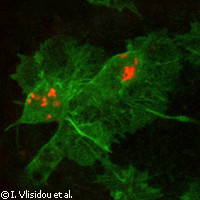Researchers watch in real time as bacteria invade fruit fly embryos
Researchers in the UK have used a novel approach to show how genetic mutants of the common fruit fly can be used to visualise, step by step, the role of bacterial toxins in infection. Their results of their real-time observations of bacterial infection in Drosophila embryos are published in the journal PLoS (Public Library of Science) Pathogens. Scientists have for many years used the fruit fly, Drosophila, to develop genetic models that help them understand microbial infection. While these models have shed light on some aspects of infection, they are limited by the fact that outcomes must be measured by death (or survival over time), and changes must be observed at fixed periods throughout infection by running tests on dead flies in a Petri dish. This makes it very difficult to observe the interactions between different stages of infection, or to dissect the critical early stages of infection, the authors explain. 'Cells often behave very differently once they have been taken out of their natural environment and cultured in a Petri dish,' said Dr Will Wood of the University of Bath in the UK. 'In the body, immune surveillance cells such as haemocytes (or macrophages [white blood cells] in vertebrates) are exposed to a battery of signals from different sources. The cells integrate these signals and react to them accordingly,' he added. Once these cells are removed from this complex environment and cultured in a Petri dish, these signals are lost. Therefore, it is really important to study whole organisms to fully understand how bacteria interact with their host.' The team injected fluorescently tagged bacteria into the Drosophila embryos and used time-lapse confocal microscopy to study the early interactions between insect phagocytes (white blood cells) and invading bacteria. The 'invaders' they used were a modified version of Escherichia coli (E. coli) that expresses a bacterial toxin called 'Makes Caterpillars Floppy' as well as the purified toxin itself. They were also able to tag individual bacterial proteins and follow their movement during infection. The results were somewhat surprising. 'Contrary to popular belief, [Drosophila embryonic hematocytes] both recognise and ingest injected Escherichia coli,' the study reads. 'This is a dynamic process in which the bacteria are recognised by, and adhere to, the phagocytes in a process that can be dramatically seen in real time using time-lapse confocal microscopy. In contrast, when cells of the insect pathogen Photorhabdus are introduced, the haemocytes become frozen and are unable to engulf the invading bacteria.' 'To be able to film the microscopic battle between single bacterial cells and immune cells in a whole animal and in real time is astounding,' commented Dr Nick Waterfield of the University of Bath. 'It will ultimately allow us to properly understand the dynamic nature of the infection process.' Richard ffrench-Constant, Professor of Molecular Natural History at the University of Exeter, added: 'For the first time this allows us to actually examine infection in real time in a real animal - it's a major advance!' 'Ultimately, to have an impact on human and animal health, the results obtained by in vitro studies need to be verified in a whole organism,' the study concludes. 'The assay we present here provides a perfect model to begin to fill these gaps and should lead to a better understanding of host-pathogen interactions in the complex setting of a multicellular organism.' The scientists hope to use their system in future studies to examine human pathogens such as Listeria and Trypanosomes. Observing how these bacteria interact with the immune system will provide valuable insights into how they cause infection, which could lead to better antibacterial treatments.
Countries
United Kingdom



